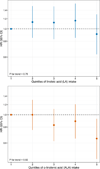Polyunsaturated fatty acids and the risk of multiple sclerosis
- PMID: 28156186
- PMCID: PMC5494026
- DOI: 10.1177/1352458517691150
Polyunsaturated fatty acids and the risk of multiple sclerosis
Abstract
Background: Results from previous studies on polyunsaturated fatty acid (PUFA) intake and multiple sclerosis (MS) risk are conflicting.
Objective: To prospectively investigate the association between dietary intake of PUFA and MS risk.
Methods: We followed 80,920 women from Nurses' Health Study (1984-2004) and 94,511 women from Nurses' Health Study II (1991-2009) who reported on diet using a validated food frequency questionnaire every 4 years and identified 479 incident MS cases during follow-up. We used Cox regression to estimate hazard ratios (HRs) and 95% confidence intervals (CIs), for the effect of PUFA intake on MS risk adjusting for age, latitude of residence at age 15, ancestry, cigarette smoking, supplemental vitamin D intake, body mass index, and total energy intake.
Results: Higher intake of total PUFA at baseline was associated with a lower risk of MS (HR top vs bottom quintile: 0.67, 95% CI: 0.49-0.90, p trend = 0.01). Among the specific types of PUFA, only α-linolenic acid (ALA) was inversely associated with MS risk (HR top vs bottom quintile: 0.61, 95% CI: 0.45-0.83, p trend = 0.001). The long-chain fatty acids eicosapentaenoic acid (EPA) and docosahexaenoic acid (DHA) were not associated with MS risk.
Conclusion: Low dietary PUFA intake may be another modifiable risk factor for MS.
Keywords: Multiple sclerosis; alpha-linolenic acid; epidemiology; polyunsaturated fatty acids; risk factors.
Figures

References
-
- Swank RL. Multiple sclerosis; a correlation of its incidence with dietary fat. Am J Med Sci. 1950;220:421–430. - PubMed
-
- Swank RL, Lerstad O, Strom A, Backer J. Multiple sclerosis in rural Norway its geographic and occupational incidence in relation to nutrition. N Engl J Med. 1952;246:722–728. - PubMed
-
- Baarnhielm M, Olsson T, Alfredsson L. Fatty fish intake is associated with decreased occurrence of multiple sclerosis. Mult Scler. 2014;20:726–732. - PubMed
-
- Kampman MT, Wilsgaard T, Mellgren SI. Outdoor activities and diet in childhood and adolescence relate to MS risk above the Arctic Circle. J Neurol. 2007;254:471–477. - PubMed
MeSH terms
Substances
Grants and funding
LinkOut - more resources
Full Text Sources
Other Literature Sources
Medical
Research Materials

